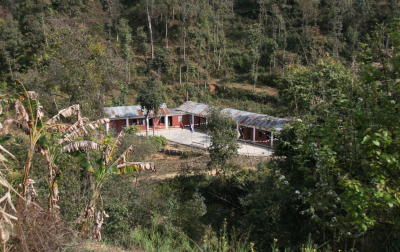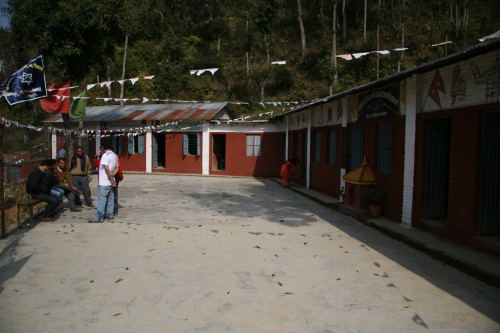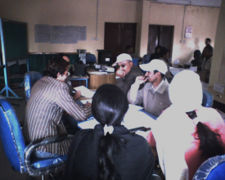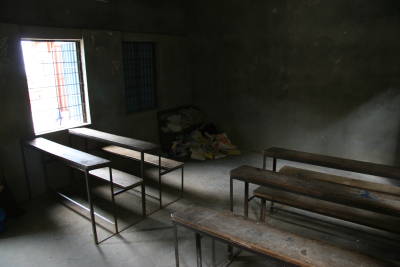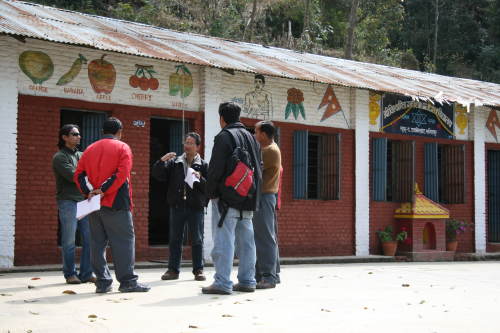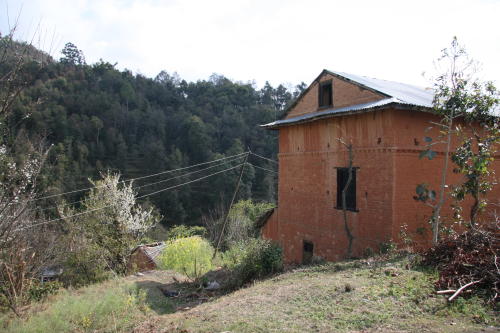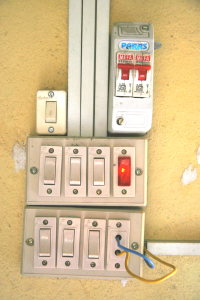Bishwamitra Journal: Difference between revisions
No edit summary |
No edit summary |
||
| Line 169: | Line 169: | ||
Coming soon . . . |
Coming soon . . . |
||
[[category:Nepal]] |
|||
Revision as of 03:11, 16 March 2008
Bishwamitra Lower Secondary School
I will note down the details of this pilot school as they happen. Bryan Berry 08:42, 7 March 2008 (EST).
See also Bashuki_Journal for information on Nepal's other pilot school.
Background
The pilot will begin on the first day of the Nepali school year, April 14th.
Community
Bishwamitra School is located in the village of Lamatar, roughly 8 km east of Kathmandu.
The School
The school is roughly 30 minutes walk from the main road. This school is more accessible than Bashuki School. It is a poor school with a mix of Dalit (untouchable), Chettry, and Brahmin children. It is physically much smaller than Bashuki school and has a smaller student population.
Below is a closer view of the school. It is physically very small and serves roughly 240 kids, classes 1-8.
Teachers from Bashuki and Bishwamitra schools attended OLE Nepal's Teacher Interaction Program held in cooperation with Nepal's National Center for Educational Development, Nepal's national teacher training organization.
The classrooms for Class 2 and 6 are the same size. Below is the room for Class 6. It measures 5.15 m x 4.21 m. The desks are 1.57 m in length and 25 cm deep. Here again it will be very easy for the laptops to fall forward off the desks. We will need to rearrange the benches so that the children are facing each other and looking sidelong at the teacher. Children will have less elbow room to type due to the small size of the benches.
Implementation Team
Open Learning Exchange Nepal is the lead implementer for the pilot, cooperating with Nepal's Department of Education. The Danish IT Society has purchased the XO's for the pilot and the Embassy of Denmark in Nepal is covering the other costs.
From the Department of Education:
- Baburam Poudel - Deputy Director at the Department of Education, oversees the OLPC project in Nepal
- Kamal Kafle - Goverment's technical adviser to the project
- Arjun Aryal - government technical advisor
From OLE Nepal
- Rabi Karmacharya, Executive Director
- Dr. Saurav Dev Bhatta, Education Director
- Mahabir Pun, Networking and Infrastructure
- Sulochan Acharya, all technical matters at the school, esp. XO's and School Server
- Dev Mohanty, Network Engineer for wireless links
- Ram Krishna Singh, power technician
- Bryan Berry, systems engineer, School Server, XO configuration, E-Library
There is also a activity development team at OLE Nepal that is working exclusively on creating constructionist learning activities for the pilot. They are less involved in the on-site implementation details.
From Bashuki School:
- Shiva Hari Dahal, principal
- Raju Ghimire, vice principal
The combined implementation team has been working together for over 4 months preparing for this pilot. It has been our experience so far that an OLPC pilot requires a significant amount of human resources. It would not be possible to implement a pilot in Nepal without full-time staff. We do not think it could be accomplished w/ a team of part-time volunteers. The OLE Nepal team includes volunteers, but the core team works on the project full-time.
I have discussed the matter of full-time staff with Amit Gogna, the lead implementer for India's first pilot at Khairat. He agrees that an OLPC implementation, even for a single school, requires full-time staff. His team has a total of 7 persons. One of the goals for our implementation team is to streamline the implemenation process for OLPC so it can be implemented with a minimum of human resources and use local resources wherever possible.
Planning
Discussing the implementation with the teachers. Dr. Saurav Dev Bhatta of OLE Nepal is in the center. Dr. Dev Bhatta is Education Director for OLE Nepal. To the left wearing sunglasses is Rabi Karmacharya, Executive Director of OLE Nepal. I (Bryan Berry) am the Director of External Relations which means I write blog posts and wiki pages detailing their work :).
Network
Mahabir Pun is in charge of all network and infrastructure planning and Dev Mohanty is the network engineer.
We may use a 12 dbi omni-directional antenna from Deliberant Networks, onsite at the school. We will likely not use the Active Antenna, at least initially. We are using a Deliberant DLB-2701 as the access point. It costs roughly 250 usd and has a range of 12 km in ideal conditions. It operates in the 802.11 b/g wifi range.
We are using Deliberant brand of radio for the point-to-point connection to the Department of Education, which is about 8 km away by road. The radio has an effective bandwidth 8 Mbps. Since the radio will be transmitting at a distance of 3 km to the Department of Education located in the Kathmandu Valley, interference will be an issue.
The school itself is a bad location for our long range antenna as it is nestled into the hillside. It does not have line-of-sight with the Department of Education. Instead we are using a house located on the hill opposite the school as a Relay site.
The owner of this house has generously agreed to let us mount our network equipment on his house. We will place the Point-to-Point antenna in the topmost window, which has a line-of-sight view with our Multi-point radio at the Department of Education. We will place our omni-directional antenna on the lower part of the roof facing towards the school. This house is roughly 100 meters from the school. We will have to test the signal strength within the classrooms. If it is too weak, we will run a Cat 6 cable down to the school. We also like putting the antenna in the house because the antenna will less likely be stolen.
We do not intend to use VSAT for any of Nepal's pilot schools. Installation is not terribly expensive but monthly bandwidth charges are prohibitively expensive when compared with the cost of long-range wifi networks, as pioneered by Nepal Wireless
Power
Ram Krishna Singh is the lead power technician for the pilot.
Stable electricity is a significant problem everywhere in Nepal. Currently the school only receives 16 hours of electricity per day. This should decrease to 15 or 14 hours per day by April. Hydropower generates most of the electricity for Nepal's energy grid and the amount generated decreases steadily during the dry season, October - May.
The school borrows power from a neighboring house and does not have its own power line. The school administators are arranging to get their own power line rated at 15 amps at our request.
Power is also of low quality, with frequent brownouts and power spikes. The power strips available in Nepal are of very low quality, there is high chance that children will shock themselves while removing their plug from the power strips. It is not uncommon to see a spark when you insert a plug into the particular power strip available in Nepal.
We will install a “charging rack” at the back of each classroom. The children will unplug the XO’s and use them at their desks untethered by power cables. There will be a space and charger for each child’s XO in the rack. We do not plan to run power cables to the desks. The chance that kids will trip over power cables is just too high.
We would love to use the Xoctoplug for power distribution should it become available. It is much more elegant and safe manner of distributing power than regular power strips. We would place the Xoctoplug in the middle of 4 desks and the kids would plug into the Xoctoplug. Since the Xoctoplug distributes DC current it is much more efficient and safer than an AC power strip. Additionally we could daisy-chain two Xoctoplugs together so that we would only have live power cable per 8 kids, as opposed to one live power cable for every 3 kids which we would need for power strips.
We will install power inverters in the school to maintain power during power outages. We will keep the inverters in the same location as the School Server.
The school currently is connected to mains [grid line] without any meter in between school and main line. The circuit breaker shown in the picture has been chosen by school arbitrarily and its rating is 5amp at 220v for the protection purpose.
As we are preparing ourselves for the pilot phase at the school, OLE wants the electrification module to be updated and make it meet the Nepali government standard and long with future requirements in mind.
We are planning to get supply at 230v with 15 amp rating so that even when the load at the school increases (for various reasons) we don't have any setback from the power sector side not only now but in the future as well.
Power requirement in school:
- Electric bulbs ~ 25-30 , Two bulbs in each class room plus additional lights in staff room, toilets and school surroundings.
- Desktop computers -2 (this number can increase)
- Server 1
- Running 40+ oplc laptops
- During winter season, staff room might have heaters
- During school function days, the power requirement might spike up pretty high.
Naturally, as the school develops and expands, power consumption also increases. Keeping these entire things in mind, we would like to prepare ourselves and leave nothing for chances.
School Server
Sulochan Acharya and Bryan Berry are in charge of the School Server, XO maintenance, and E-Library.
The school server will use OLPC's school server distribution with some modifications. The School Servers will not connect directly to the Internet but through a server located at the Department of education. This server will host the Dansguardian content filter and Squid proxy. The School Server will only host the Jabber Server, DNS, DHCP, and a few other services. We are using off-the-shelf hardware for the school server.
We will keep the school server and power inverters.
Physical Security
Bishwamitra school is more physically secure than Bashuki school. There is a tall chain-link fence topped with barbed wire surrounding the school. There are locks on all the classrooms.
We expect the children to take their XO's home with them but the School Server, power backup equipment, and charging racks will need to be secured. Power backup equipment is particularly valuable in Nepal due to supply shortages.
Teacher Training
Teachers will receive four days of training off-site 1-2 weeks prior to the pilot. Each teacher will receive their own laptop. More details to come . . .
We held a Teacher Interaction Program on January 14th that shaped many aspects of our teacher training plan.
Content Development and Content Acquisition
OLE Nepal is developing E-Paati suite of learning activities for the pilot. These activities were developed in EToys and are under the MIT license. So far the E-Paati suite contains mathematics and English activities for grades two and six. We feel that developing local content is extremely important for the success of this pilot. Child-centered, constructionist learning is a foreign concept for most Nepali schools. Our plan is to gently introduce constructivist, interactive learning activities that are based on the current Nepali learning materials. This way, the new materials will be less alien and the mode of instruction more readily adopted. We don't want to force a completely new mode of teaching and learning onto the teachers from day one.
Content Acquisition is a time-consuming process. Several groups that create storybooks and children's literature have already contributed digital versions of their materials for the pilot. These materials will be licensed under the Creative Commons 3.0 Attribution-NonCommercial-NoDerivatives license. We strongly prefer to not have the No Derivatives clause but we have found it difficult to convince publishers to allow derivatives.
School Selection Process
The Department of Education selected Bishwamitra school based on the following criteria:
- A poor school
- Majority of students come from disadvantaged castes
- Relatively remote location but accessible from Kathmandu
- School already has electricity
Why Classes 2 and 6? Why mathematics and English?
We chose Class 2 over Class 1? Because a large portion of Nepali schoolchildren do not attend preschool. In grade one they are just getting used to being in school. With Class 2, they are already accustomed to attending school but young enough that we can measure how well this initiative helps young children.
We chose class 6 because a large portion of Nepali children drop at class 6. Also, we can test out more complicated learning activities and this challenges us to see how well our strategies work with higher subjects. In 2009, we plan to expand to classes 3 and 7, 2010 to 4 and 8, until we cover all public school grades.
Nepali students perform very poorly in mathematics and English on standardized exams. These are also the most valued skills. We think we can make the most positive impacts here.
Maintenance Plan
We will show the teachers how to perform basic maintenance and give periodic short courses to the students on laptop maintenance. Rather create a fully structured maintenance plan, we want to see who at the school shows the most affinity for laptop maintenance, students or teachers. We don't want to arbitrarily select local people to do the maintenance until we get a sense of who has an interest and talent for it. In short, we are putting People before Process.
Evaluation
Experiences
Coming soon . . .
